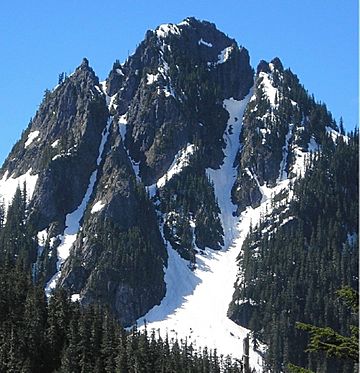Lane Peak facts for kids
Quick facts for kids Lane Peak |
|
|---|---|
 |
|
| Highest point | |
| Elevation | 6,012 ft (1,832 m) |
| Prominence | 332 ft (101 m) |
| Isolation | 0.71 mi (1.14 km) |
| Geography | |
| Location | Mount Rainier National Park Lewis County, Washington, U.S. |
| Parent range | Cascades |
| Topo map | USGS Mount Rainier West |
| Climbing | |
| Easiest route | Scrambling class 4 |
Lane Peak is a mountain peak located in the state of Washington, in the U.S.. It is part of the Tatoosh Range, which is a smaller mountain range within the larger Cascade Range. You can find Lane Peak just south of the famous Mount Rainier, inside Mount Rainier National Park.
This peak was named in honor of Franklin Knight Lane. He was an important government official who served as the United States Secretary of the Interior. In 1917, he played a key role in creating the National Park Service. This service helps protect and manage many beautiful natural areas, like Mount Rainier National Park, for everyone to enjoy. Water from the south side of Lane Peak flows into rivers that join the Cowlitz River. Water from the north side flows into rivers that join the Nisqually River.
Contents
Understanding Lane Peak's Climate
Lane Peak is in a special weather area called the "marine west coast climate zone." This type of climate is found in western North America. It means the weather is often influenced by the nearby Pacific Ocean.
How Weather Forms at Lane Peak
Most of the weather systems that affect Lane Peak start far away in the Pacific Ocean. These systems, called "weather fronts," usually travel northeast. When they reach the tall Cascade Mountains, the air in these fronts is forced to rise. This process is called Orographic lift. As the air rises, it cools down and drops its moisture. This moisture falls as rain or snowfall onto the mountains.
Winter and Summer Weather
Because of this, the western side of the Cascade Mountains gets a lot of precipitation, especially in winter. Most of this precipitation comes down as heavy snow. Even though it snows a lot, the temperatures usually stay mild. It rarely gets colder than 0 °F (−18 °C) or warmer than 80 °F (27 °C). In winter, it's often cloudy, but during the summer, high-pressure systems over the Pacific Ocean usually bring clear skies. The snow here tends to be wet and heavy, which can sometimes lead to a high risk of avalanches.
Climbing Routes on Lane Peak
Lane Peak is a popular spot for climbers. There are several known routes that people use to reach the summit. These routes can involve different types of climbing, from walking on snow to more challenging rock and ice sections.
- Lover's Lane - This route involves moderate snow climbing.
- The Zipper - This route includes steep snow and some ice climbing sections.
- The Fly
- South Face
- For more information about the park: Mount Rainier National Park
- To check the weather forecast for Lane Peak: Lane Peak Weather



